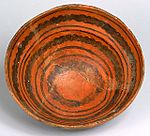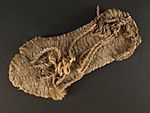Pueblo II Period facts for kids
The Pueblo II Period was a time in history for the Ancestral Puebloans, who lived in the Four Corners area of the American Southwest. This period lasted from about AD 900 to AD 1150. During this time, people built homes using stone and mortar. They also gathered in special underground rooms called kivas for community events.
People in the Pueblo II Period also built tall towers and dams to collect water. They used special grinding areas called milling bins to process their corn. If a community didn't grow enough food, they would trade pottery with other villages for corn. This period came after the Pueblo I Period and before the Pueblo III Period.
Contents
Building Homes and Villages
During the Pueblo II Period, villages became much larger. They had more community buildings than in the earlier Pueblo I Period. Most buildings were made from strong stone. Around AD 1075, builders started using a technique called "double-coursed masonry." This meant using two layers of stone, which made buildings strong enough for a second story. Stone homes were much tougher and safer from fire than older types of houses.
These groups of homes were sometimes called "unit pueblos." Some villages followed a common layout. They had pairs of rooms, with front rooms for living and back rooms for storage.
Kivas and Towers
Kivas were round, underground rooms used for special ceremonies. They were built in a standard way across different villages. Some very large kivas, called great kivas, were built for big community gatherings. These could be as wide as 17 meters (55 feet)!
People also built towers, some up to 4.5 meters (15 feet) tall. These towers were often connected to housing areas and had underground paths to a kiva. They might have also been used as lookout posts. Villagers usually placed their trash piles to the south of their homes.
Life in the Communities
Four Corners Region
The Southwest was a very dry place, and the population was growing. Because of this, communities spread out and started new villages and farms. Over 10,000 new sites were created in just 150 years! During the Pueblo II Period, almost every piece of land that could be farmed was used for growing crops.
There isn't much evidence of hunter-gatherer groups in the Four Corners area during this time. It's possible they either moved to other areas to find food, or they joined the Pueblo people and started farming.
Mesa Verde
In the Mesa Verde National Park area, homes were built in long rows. These buildings often formed E, U, or L shapes and were usually built around a central open space called a plaza.
Chaco Canyon
Beautiful, large buildings called great houses continued to be built at Chaco Canyon. These structures were much bigger than earlier homes. They had high ceilings and rooms that were three or four times larger than regular houses. They also featured special kivas, including very large ones, tower kivas, and kivas built above ground.
- Chimney Rock: This site was connected to the larger Chaco Canyon system.
-
Agate House at Petrified Forest National Park in Arizona.
Culture and Beliefs
Religion
During this period, community activities became more important. This included special ceremonies held in the great kivas.
Wall Art
Petroglyphs, which are designs carved into rock, became common throughout the Little Colorado River basin. Some of these rock carvings were "solar markers." They helped people track the seasons by showing the sun's position during equinoxes and solstices.
Farming and Food
Building dams and reservoirs to save water was a big community effort. Some reservoirs, like one near Far View House in Mesa Verde National Park, could be 27 meters (90 feet) wide and 3.6 meters (12 feet) deep! People also built terraced check dams on hillsides. These dams collected melting snow or rainwater, holding moisture and rich soil. This created perfect conditions for farming in the dry Southwest.
The population grew a lot, so villages needed more food. Farmers experimented with growing larger corn cobs, including types from Mexico and local mixes. People also hunted animals and gathered wild plants from small areas not used for farming. However, as more people lived in the area, wild food and game became harder to find.
The best places for farming were near springs, seeps, or marshes. Early in the Pueblo II Period, these good spots were already taken. Younger families had to look for new land, hoping there would be enough rain for their crops. There were times of hunger and drought, and elders told stories of people moving away from their villages to "follow the rains." Signs of near starvation in children, like interrupted growth lines in their bones, show how tough these times could be.
Processing Food
The number of rooms used for work and storage increased. Many of these rooms were inside the homes, and some were deep pit-houses. Nearly a quarter of all rooms were used for grinding corn. These "mealing bins" were set up side-by-side, allowing people to grind corn together using metates and manos.
Pottery and Trade
Common pottery styles included corrugated gray ware and decorated black-on-white pottery. Corrugated pottery was made by coiling clay and then pinching it to create a bumpy texture. Besides cooking and storage pots, people made bowls, jars with lids, mugs, ladles, canteens, pitchers, and pots shaped like birds and animals.
Pottery was important for trade, especially for communities that couldn't grow enough food. This helped people get the food they needed and allowed those with good farmland to focus on growing crops. For example, the Chaco Canyon area produced a lot of extra food, which they traded for pottery.
-
Anasazi bowl (trade ware) from 900–1100, found at Chaco Culture National Historical Park.
Other Tools and Goods
Many everyday items stayed similar to earlier periods. These included:
- Stone tools like axes, hammerstones, knives, and scrapers.
- Manos and metates for grinding corn and plants.
- Bone awls, scrapers, and projectile points.
- Bows and arrows.
- Snares for hunting.
- Pottery.
- Digging sticks for farming.
- Clothing made from cotton, yucca plants, or animal hides.
- Hard cradle boards, which were first used in the Pueblo I Period.
- Gaming pieces, pendants, and beads.
Cultural Groups
Several cultural groups lived during this period:
- Ancestral Puebloans – in southern Utah, southern Colorado, northern Arizona, and northern and central New Mexico.
- Hohokam – in southern Arizona.
- Mogollon – in southeastern Arizona, southern New Mexico, and northern Mexico.
- Patayan – in western Arizona, California, and Baja California.
Important Pueblo II Sites









